CURRENT / UPCOMING

O Ato de Caminhar - The Act of Walking
11 October 2021 – 01 May 2022
Museu do Calçado Portugal
Curated by: Joana Galhano
https://www.museu-do-calcado.pt
O Ato de Caminhar - The Act of Walking is a solo exhibition at the Museu do Calçado Portugal. On display are a selection of footwear works from ten Bhömer’s extensive archive, video works and two installations. A catalogue accompanies the exhibition and can be found here.
“Crossing very diverse areas and disciplines, Marloes ten Bhömer is raw in the way she presents herself and her work to society, she is critical when she rejects the stereotypes and identity imbalances that the fashion industry promotes, she is challenging when she questions gender in “traditionally” masculine disciplines, she is liberating when she analyses the peripheral role of women in cinema - through the act of walking - and proposes to us all alternative models of thinking. For Marloes ten Bhömer, footwear is a powerful means of expression, evocation, provocation, questioning and above all renewal.”
Joana Galhano, curator of the exhibition.
________________________________________________________________________________________________________________________
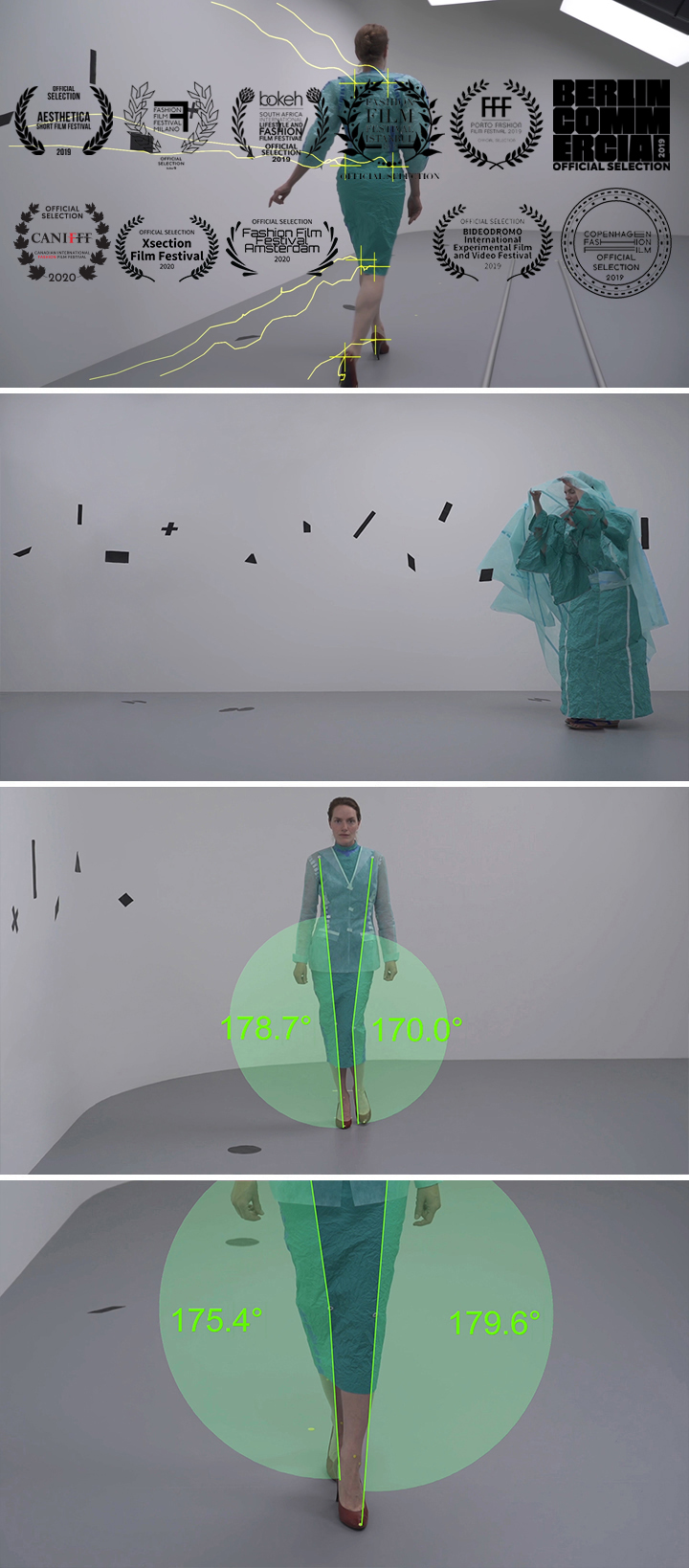
The Path She Walks / 2018
Commissioned by Kyoto D-Lab
Running time: 06:20 min
Project Direction: Professor Julia Cassim
Motion Analysis Supervision: Associate Professor Noriyuki Kida
Studio Supervision: Assistant Professor Yasushi Ichikawa
Motion Analysis: Tomohiro Inoue[KYOTO Design Lab Digital Factory]
Cinematography: Tomohiro Tanaka
Studio Supervision: Shin Yamashita[KYOTO Design Lab Wood Factory]
Soundtrack: Remco de Jong
Special thanks to Noam & Nika Toran, Marine Zorea, Naoko Minami & Kingston University
The Path She Walks was created during Kyoto D-Lab’s Designer in Residence Programme and won the Best Idea award at Copenhagen Fashion Film Festival 2019, a Special Mention at BIDEODROMO International Experimental Film and Video Festival Bilbao 2019 and Best Fashion Short Award at Athens Fashion Film Festival 2020.
About the Residency
Kyoto D-Lab’s Designer in Residence Programme invites art and design reasearchers to KIT to develop new signature works in response to the Kyoto Institute of Technology KIT context and the major research themes of KYOTO Design Lab. The exhibition Walking Women + The Reanimated Archive centres on a joint two-month residency by Noam Toran and Marloes ten Bhömer at Kyoto D-Lab.
Walking Women
During her residency at KYOTO Design Lab, ten Bhömer collated a taxonomy of movement derived from traditional Japanese footwear and its underlying culture. Her research considers the role that design and media play in the social and cultural formation of the Japanese ‘woman in motion.’ The aim is to challenge hardened typologies and stereotypes relating to a woman’s social and physical mobility. Her focus was classic Japanese cinema and digital characters. Employing motion analysis technology, ten Bhömer highlights the ingrained nature of a woman’s gait and how her movements are affected by such dynamics as learned behaviour and social custom. This research cumultated in the following works: The Path She Walks and Marloes as Miku.
In parallel, she investigated traditional Japanese footwear from a functional design perspective and proposes new approaches to footwear design and production. The aim of the project is not to look at shoes solely as a commercial, cultural or historical object. Rather it is to develop a design methodology that brings practical, technical and material conditions and opportunities to the fore. This research cumultated in the following works: Historic Japanese Footwear Research, Morphologic Chart and Washi Spray-On Shoe Tests. The works are part of ongoing research.
The Path She Walks
In The Path She Walks, ten Bhömer investigates female gait in cinema to understand traditional Japanese footwear and the kinematics of gait. Walking and gait in relation to shoes and garments is imbued with learned movements, restrictions and the wearer’s idiosyncratic movements. Walking in cinema embodies other cultural and socio-political elements too, such as the construction of identity, thus making it much richer point of study than a mere technique.
In analysing the films, ten Bhömer found that a focus on a woman’s gait in Japanese and non-Japanese cinema alike often denoted a cinematic metaphor: the female protagonist is or has just undergone a change in the direction of her life. In Kenji Mizoguchi’s The Life of Oharu (1952), for example, the titular character, played by Kinuyo Tanaka, undergoes many dramatic social changes in her life, which are symbolically represented by the sheer volume of walking throughout the film. Ten Bhömer re-enacts a selection of cinematic gait moments and dissects them across cultural, social and anatomic lines. Producing a film which sits between performance art, fashion film and scientific analysis, the footage having been examined with high performance motion software. The Path She Walks reveals the relationship between gait, footwear, clothing, movement, character development and performing identity.
Films cited:
Vertigo -1958 / Dir: Alfred Hitchcock / Actress: Kim Novak
Where Chimneys are Seen - 1953 / Dir: Heinosuke Gosho / Actress: Ranko Hanai and Chieko Seki
Throne Of Blood -1957 / Dir: Akira Kurosawa / Actress: Isuzu Yamada
Life of Oharu -1952 / Dir: Kenji Mizoguchi / Actress: Kinuyo Tanaka
When a Woman Ascends the Stairs -1960 / Dir: Mikio Naruse / Actress: Hideko Takamine
Mars Attacks -1996 / Dir: Tim Burton / Actress: Lisa Marie
Kuroneko (DAUGHTER sequence) -1968 / Dir: Kaneto Shindô / Actress: Kichiemon Nakamura
Kuroneko (MOTHER sequence) -1968 / Dir: Kaneto Shindô / Actress: Nobuko Otowa
Niagara -1953 / Dir: Henry Hathaway / Actress: Marilyn Monroe
________________________________________________________________________________________________________________________

Bluepanelshoe / 2015
Materials: leather and stainless steel
Commissioned by the Design Museum London for the exhibition:
Life on Foot 2, 13 May - 1 November 2015
Curated by Pete Collard and Anniina Koivu
www.designmuseum.org
Bluepanelshoe is an extension of the research conducted during the Stanley Picker Fellowship, the initial results of which were accumulated in the exhibition A Measurable Factor Sets the Conditions of its Operation in 2013. One of the focus points of the fellowship – alongside an examination of the cultural connotations of women’s footwear – was research into the structural parameters required to support a foot (in a high-heeled position) while in motion. These parameters were derived from anatomic and kinematic studies, with the aim to use them as a base to generate new footwear possibilities. A series of 17 ‘hypotheses’ for high-heeled footwear were produced, each one a different mapping of foot-to-ground contact points, or ‘constellations’.
The maps were produced both as a set of silkscreen prints titled Constellations (2013) and as computer models. These contact point constellations were also produced as physical, 3D printed testing shoes titled White Prototypes (2013).
Bluepanelshoe, the first shoe generated from one of the 17 hypothetical constellations, is based on the following anatomic insight: In barefoot ambulant motion the heel strikes on the lateral side of the foot and propels the foot through the big toe. The hypothesis is that in high-heeled ambulant motion, the heel (both the heel of the foot and the physical shoe part) should also strike on the lateral side of the foot. The resulting heel design derived from these parameters would make the foot prone to eversion and inversion. In order to negate this motion, a ring shaped constellation of contact is placed around the foot.
By ignoring the sandwich method – the traditional manner in which shoes are produced – and basing the design on these structural parameters and adhering contact constellations instead, the aesthetic and structural possibilities open up completely. Congruently, these new set of parameters, which shirk fashion trends, allow for new shoe typologies which defy cultural stigmas that too often lead to the stereotyping of women.
Mapping of foot-to-ground contact points followed by computer model (in mint green) for 3D printing the testing shoes White Prototypes (2013).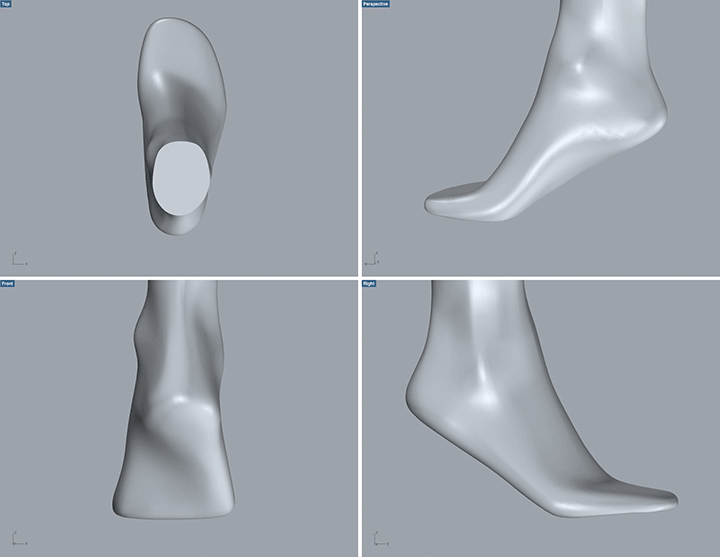 Constellations (2013) silkscreen print on paper.
Constellations (2013) silkscreen print on paper.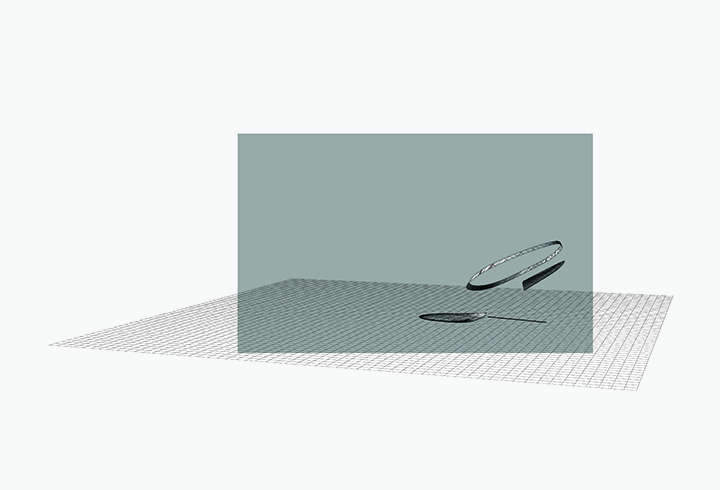 White Prototypes (2012-2013) nylon rapid prototyped and high impact polystyrene.
White Prototypes (2012-2013) nylon rapid prototyped and high impact polystyrene. Bluepanelshoe (2015) leather and stainless steel.
Bluepanelshoe (2015) leather and stainless steel.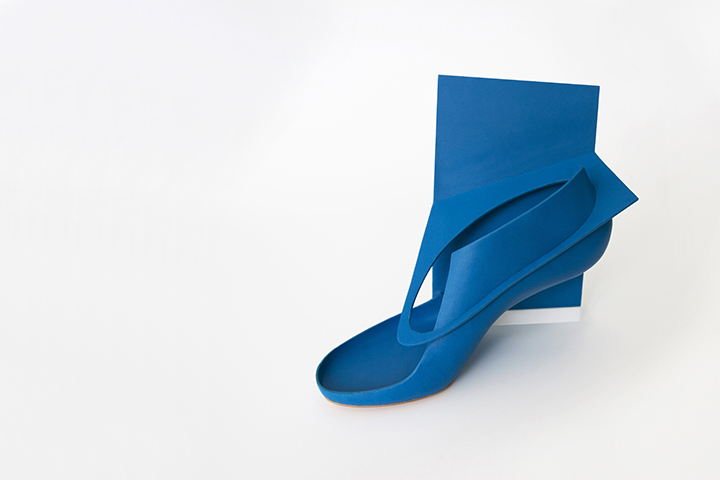 ________________________________________________________________________________________________________________________
________________________________________________________________________________________________________________________
 Annabelle, Barbra, Becky, Alexis, Krystle, Ellen, Olive, Eve and Kirsten, not stumbling, sliding, sinking falling or oblivious / 2014
Annabelle, Barbra, Becky, Alexis, Krystle, Ellen, Olive, Eve and Kirsten, not stumbling, sliding, sinking falling or oblivious / 2014
Commissioned by Transition Gallery for Folkestone Fringe Festival
Folkestone Triennial Fringe 29 August – 4 October 2014
Video: Shot on Sony FS700 at 200 FPS
Running time: 05:00 min
Art Director: Noam Toran
Director of photography: Per Tingleff
Soundtrack: Sam Conran
Color Grading: Martin Sansom
The relationship between mobility and women is intriguing and complex. In media such as cinema, television and fashion photography (and even in early Muybridge photography), the female subject can often be found lying down, sometimes sexually inviting, sometimes lethargic, and sometimes, as seen in a recent Marc Jacobs’ advert or in any of the countless TV crime serials, literally lifeless. Her immobility suggests a lack of energy, agency or power, or worse, personality. The inert female subject becomes a mannequin, inanimate, objectified and fetishised, and this demeaning representation suggests darker social forces at work. Annabelle, Barbra, Becky, Alexis, Krystle, Ellen, Olive, Eve and Kirsten, not stumbling, sliding, sinking falling or oblivious (2014) questions contemporary social constructions of women, and to what extent notions of mobility play a role. The video piece references moments in cinematic history where a women’s mobility has been compromised for various reasons: to provide suspense, to bring about a character assassination, to satirise, to provide comedic relief, to silence a voice.
________________________________________________________________________________________________________________________ A Measurable Factor Sets the Conditions of its Operation / 2013
A Measurable Factor Sets the Conditions of its Operation / 2013
13 February - 6 April 2013
Stanley Picker Gallery
Faculty of Art, Design & Architecture
Kingston University, Knights Park
Kingston upon Thames KT1 2QJ
www.stanleypickergallery.org
A Measurable Factor Sets the Conditions of its Operation is an exhibition of investigative pieces, processes, tests and trials for a new footwear collection informed by engineering principles. Marloes ten Bhömer's aim is to completely replace the standard and regimented approaches to footwear design and manufacturing with the working processes of engineering. This method, which purposefully shirks fashion trends and styles, is based on research into the structural parameters required to support a foot (in a high-heeled position) while in motion.
Displayed throughout the exhibition are artifacts from a series of structural, aesthetic and cultural experiments and outcomes, conducted and produced over the course of a year. The White Prototypes (2012-2013) displayed on the shelves are test pieces, mapping out specific combinations of foot and ground contact points derived from anatomical and kinematic studies. Alongside them are a collection of sketches, construction rigs, slow-motion video footage, pressure-mat analyses, prototypes of various complexities, film compilations, prints and slides. Intuitive experiments and analytical studies, observations and inferences, triumphs and failures, are all presented together in the gallery installation.
As demonstrated in the projected video Material Compulsion (2013), the high-heeled woman is a complex construct, one designed for, and ultimately sanctioned to, the man-made environment. When placed in alternative settings (through the narrative of a film, for example) or when forced to walk through unique substrates, a woman in heels loses her equilibrium (both physically and culturally) and begins to slip, trip, sink or tumble, thereby transforming her perceived identity.
The consequences of ten Bhömer's extensive research methodology, developed over the course of her Stanley Picker Fellowship (2011-2013) at Kingston University, are two-fold: First, the approach reveals a link between rationalised parameters, aesthetic intuition and structural understanding. Second, by considering 'the woman in motion' as an engineering problem, she exposes and questions the role high heels play in the cultural construction of female identity.
A Stanley Picker Fellowship Research Project (Kingston University)
A special thank you to: Ioannis Belimpasakis, James Brouner, Marc Bultitude, Kenny Evans, Laura Hodson, Phil Hollins, Graeme MacKay, Stephanie Jayne Price, Emma Rummins, Nicola Swann, Jane and James at Sugru, Per Tingleff, Noam Toran, Nick Williamson
and the Stanley Picker Gallery team.
Photography: Ellie Laycock.
Concept development during the Jerusalem Center For The Visual Arts residency 2010
http://www.jcva.org Material Compulsion / 2013
Material Compulsion / 2013
Video: Shot on Phantom HD at 500 FPS
Running time: 12:19 min
Director of photography: Per Tingleff
Art Director: Noam Toran
Marloes ten Bhömer talks about her research practice and Stanley Picker Fellowship as part of the Design Symposium in memory of Alex Ward, Senior Curator of Design and Architecture, Israel Museum, Jerusalem, 1999−2012
Held on November 11, 2013 at the Springer Auditorium, The Israel Museum, Jerusalem
 ________________________________________________________________________________________________________________________
________________________________________________________________________________________________________________________
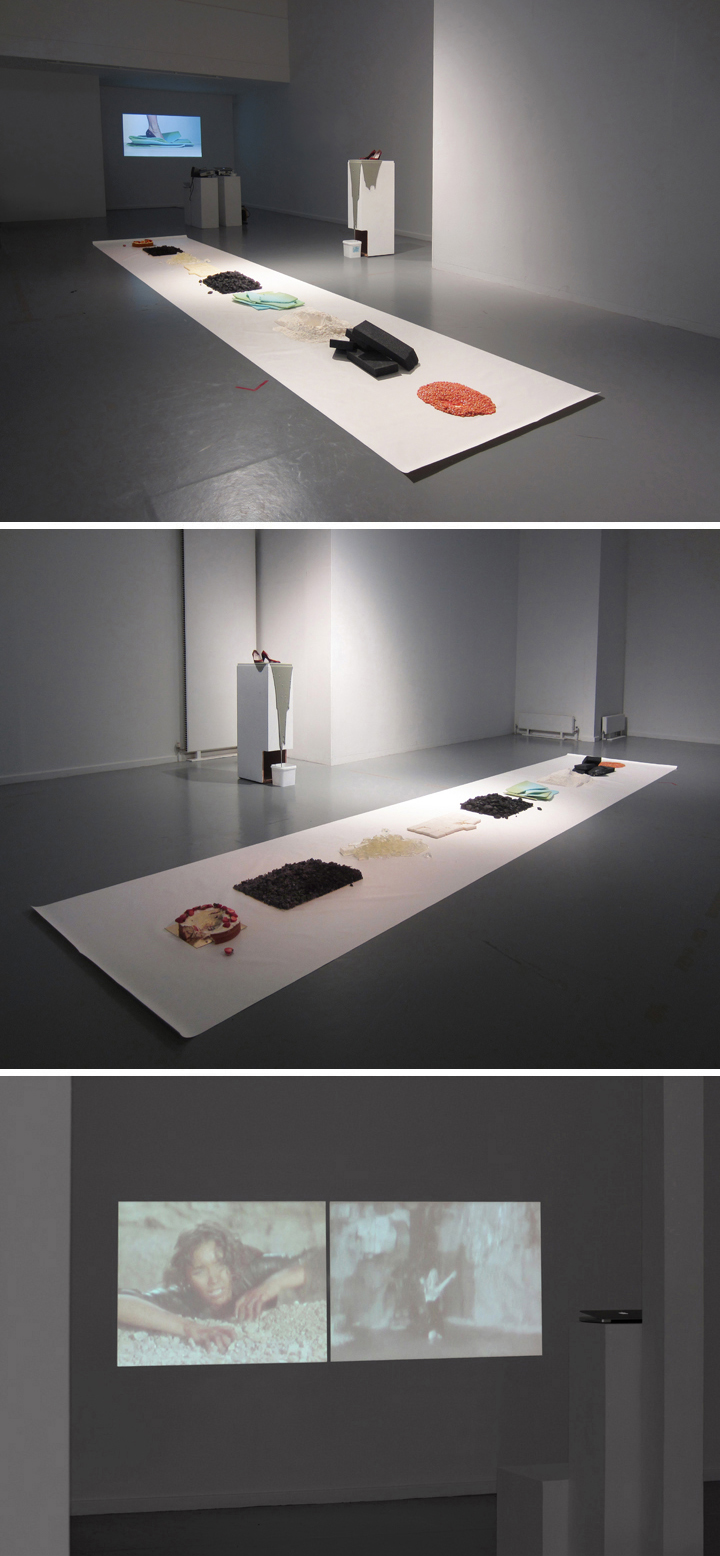
Material Compulsion / 2012
Videos: Shot on digital camera
Materials: Cake, mud, gelatine, lard, coal, foam, flower, foam and baked beans
Material Compulsion is a series of film tests produced as part of Stanley Picker Fellow Marloes ten Bhömer’s research into the cultural positioning of the high-heel.
________________________________________________________________________________________________________________________
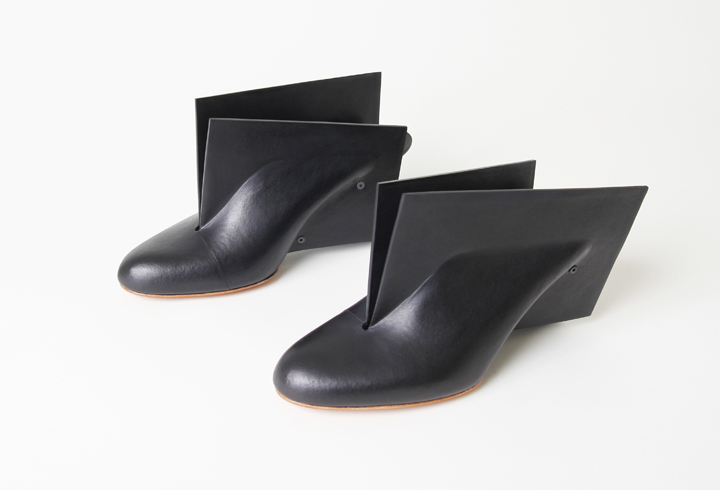
Blackmouldedleathershoe / 2011
Materials: leather and plastics
Best of British, 26 July - 9 September 2012
British Business Embassy Lancaster House
Curated by the Crafts Council
Blackmouldedleathershoe is made using a leather processing technique in which leather is soaked in water and pressed in between a two-part mould, forming it into a three-dimensional shape. The leather parts are then dried, cut and assembled into a shoe. The heel is placed as a wedge between the two leather parts. The technique is based on production principles of industrial components, despite the usually association of leather with luxury and hand making.
________________________________________________________________________________________________________________________
 Pressedleathershoe / 2011
Pressedleathershoe / 2011
Materials: leather and plastics
Pressedleathershoe is made using a leather processing technique in which leather is soaked in water and pressed in between a two-part mould, forming it into a three-dimensional shape. The leather parts are then dried, cut and assembled into one shoe, embedding the structure that gives the shoe it’s strength. Blackpressedleathershoe is made from three preformed leather parts. The project is a commissioned by Formula Fashion and on display are material tests, mould parts, vacuum formed design tests and the final shoe.
Formula Fashion
Silverstone Circuit, 8 June 2011 – 9 June 2011
Silverstone Circuit, 8 July 2011 – 9 July 2011
Silverstone Circuit, 22 July 2011 – 24 July 2011
The University of Northampton, 22 August – 5 September 2011
Northampton Museum and Art Gallery, 8 September – 21 September 2011
The National Centre for Craft & Design Sleaford, 24 September – 6 November 2011
Formula Fashion is part of Igniting Ambition, a Cultural Olympiad programme in the East Midlands. Formula Fashion is showcasing new commissioned works inspired by a fusion of motorsport, art, leatherwork and cutting edge design. Other exhibitors: Kei Ito, Aasen Stephenson, Genevieve Bennett and Jo Cope.
Partners: Silverstone Holdings Ltd, Northamptonshire County Council, South Northamptonshire Council, Northamptonshire Enterprise Limited , University of Northampton (incorporating the School of Arts) , Design Factory.
________________________________________________________________________________________________________________________
 Industrious|Artefacts, the evolution of crafts, 26 May 2011 - 12 February 2012
Industrious|Artefacts, the evolution of crafts, 26 May 2011 - 12 February 2012
Zuiderzeemuseum, the Netherlands
Curators: Studio Makkink & Bey
Other exhibitors; Claire Warnier and Dries Verbruggen, Studio Glithero and Studio Makkink & Bey.
Guest curators Rianne Makkink and Jurgen Bey address the evolution of production processes and small industries through the work of Dutch and international designers.
Works on display:
Rotationalmouldedshoe / 2009
Rotationalmouldingmachine / 2009
Mutant Parade / 2009
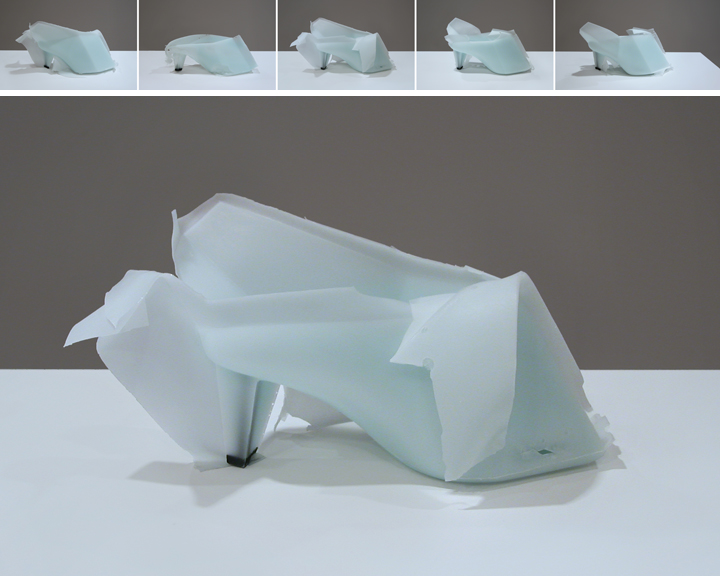 Mutant Parade / 2009
Mutant Parade / 2009
Materials: Polyurethane rubber and stainless steel
Rotational moulding is a process in which a negative mould is filled with a small amount liquid and as the mould starts to rotate, this material solidifies against the inner walls of the mould, forming a shell, a hollow form. Rotationalmouldedshoe was specifically designed for the "After Hours" installation in the Krannert Art Museum in Illinois, USA. After Hours presents the step-by-step procedure for making Rotationalmouldedshoe, from material developments and experiments to the pouring, moulding and de-moulding process, along with a menagerie of material tests and failures "Mutant Parade", culminating in the finished pair.
________________________________________________________________________________________________________________________
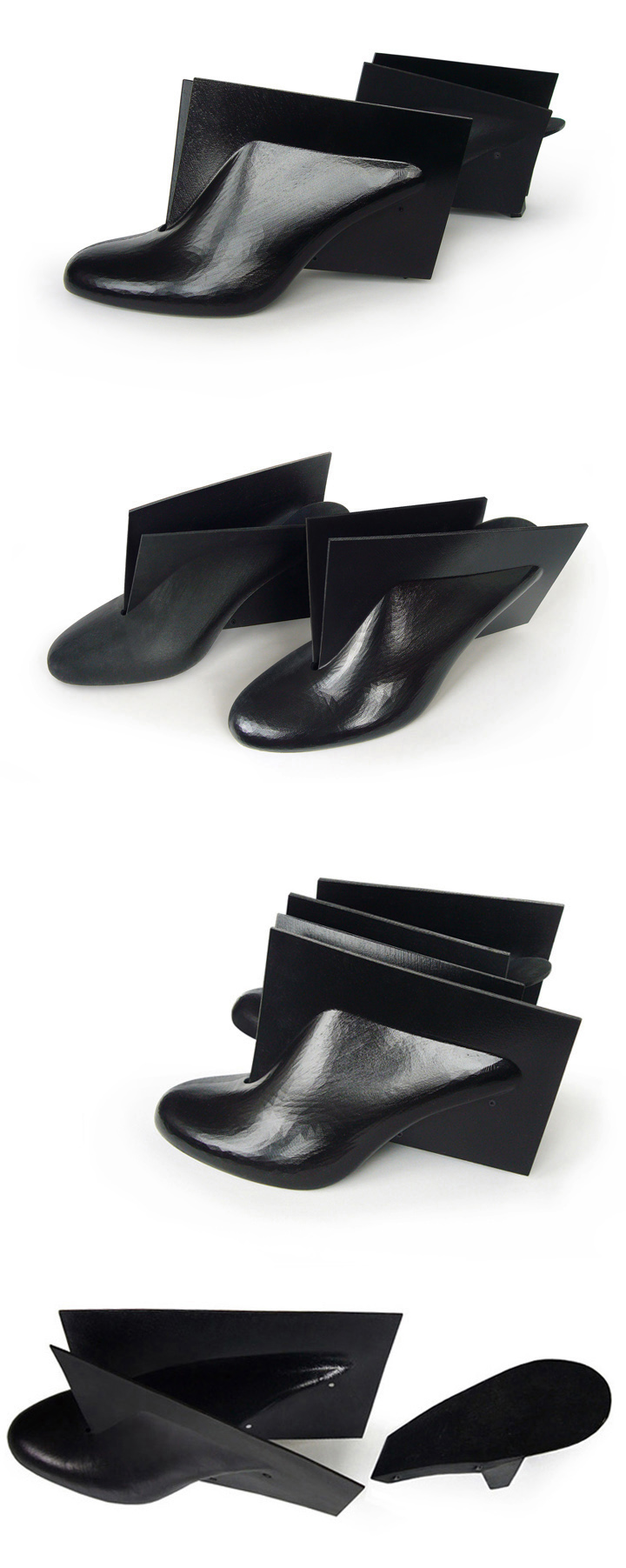 Rapidprototypedshoe / 2010Printed on an Objet Printing System
Rapidprototypedshoe / 2010Printed on an Objet Printing System
Mechanical Couture; Fashioning a New Order, 14 October 2010 – 8 January 2011
Design Museum Holon, Israel
Curators: Curatorsquared; Ginger Gregg Duggan and Judith Hoos Fox
Other exhibitors; Dai Fujiwara, Shelley Fox, Ying Gao and Simon Thorogood
www.dmh.org.il
Rapidprototypedshoe is made using an additive manufacturing technology in which successive layers of a photopolymer material are UV cured. The shoe is built in one go, but is comprised of two materials, which are organised into different microscopic structures, thereby enabling different material properties. As a result, the shoe has both flexible and rigid sections. The shoe has been designed to be disassembled for the purpose of replacing parts, despite having never been assembled in the first place.
When moving from rapid prototyping to rapid manufacturing, inherent construction possibilities and aesthetics of the production method needs to be explored. Certain design and production details such as the punch holes and screws in this design are not a derivative of this production method, but still make constructive sense.
Construct #2 / 2010
Construct #2 shows the step-by-step digital procedure for creating Rapidprototypedshoe. The series includes microscopic images of the material Rapidprototypedshoe has been made from, in both a liquid and cured state.
Shoe last.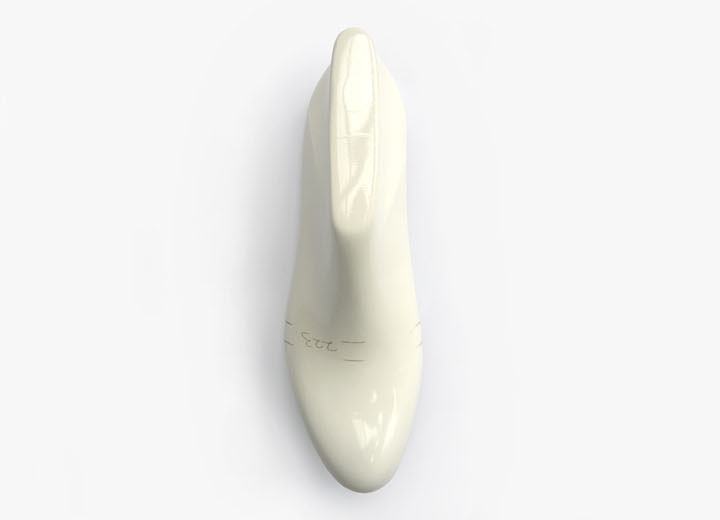 Digitising shoe last.
Digitising shoe last.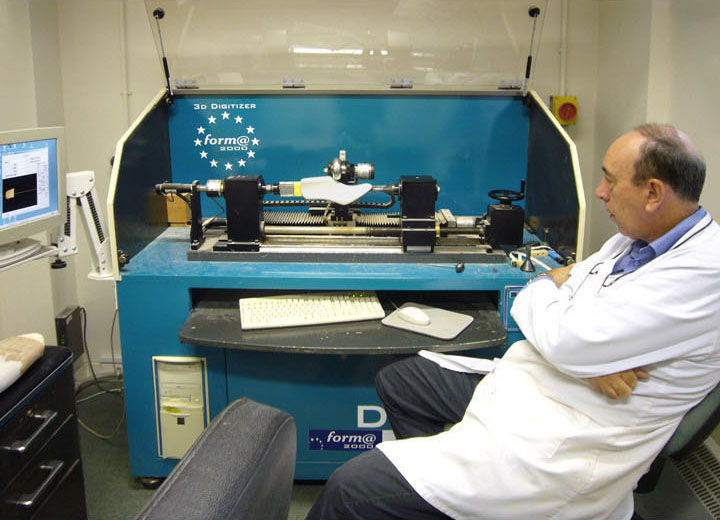 VeroBlack material cartridge for Objet's Connex500 multi-material 3D printing machine.
VeroBlack material cartridge for Objet's Connex500 multi-material 3D printing machine.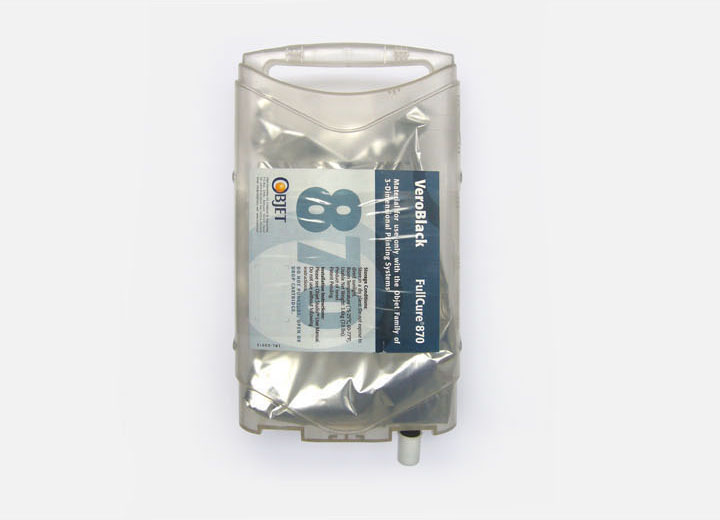 Creating 3D file in Rhino.
Creating 3D file in Rhino.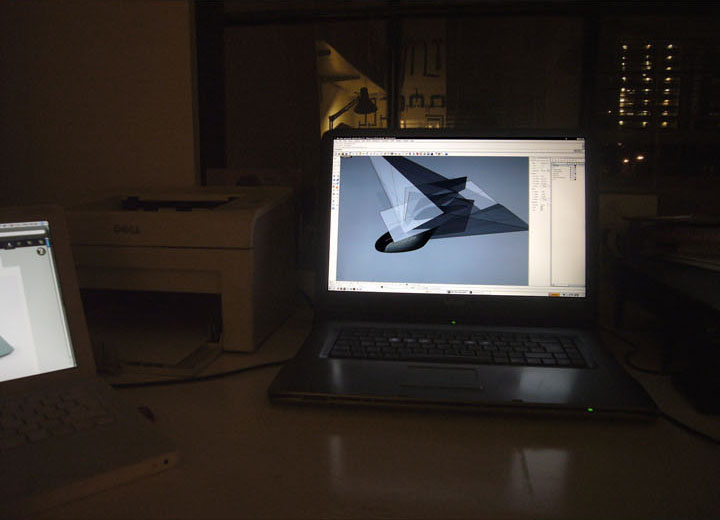 Digital microscopic image 50X zoom of VeroBlack material in liquid state.
Digital microscopic image 50X zoom of VeroBlack material in liquid state. Digital microscopic image 50X zoom of VeroBlack material in built state.
Digital microscopic image 50X zoom of VeroBlack material in built state.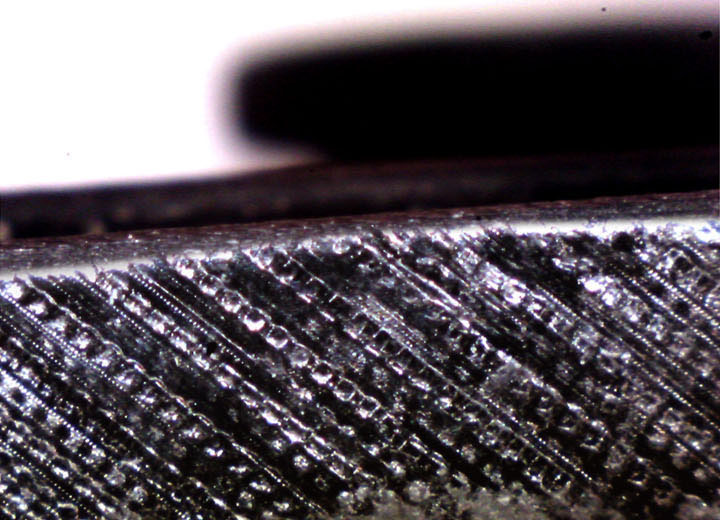 Digital microscopic image 50X zoom of VeroBlack scaffold material.
Digital microscopic image 50X zoom of VeroBlack scaffold material. 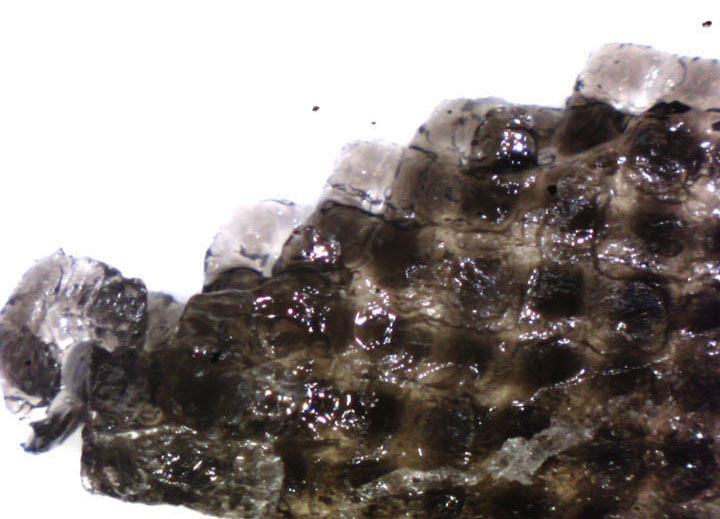 Rapidprototypedshoe.
Rapidprototypedshoe.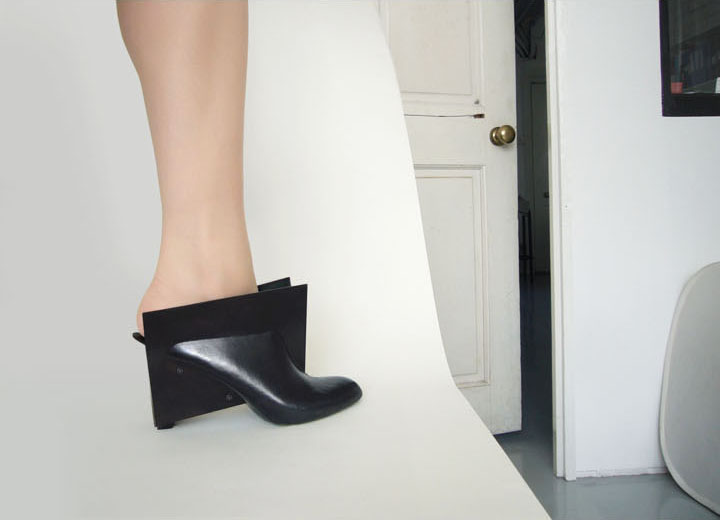 Exhibition shot, Design Museum Holon.
Exhibition shot, Design Museum Holon.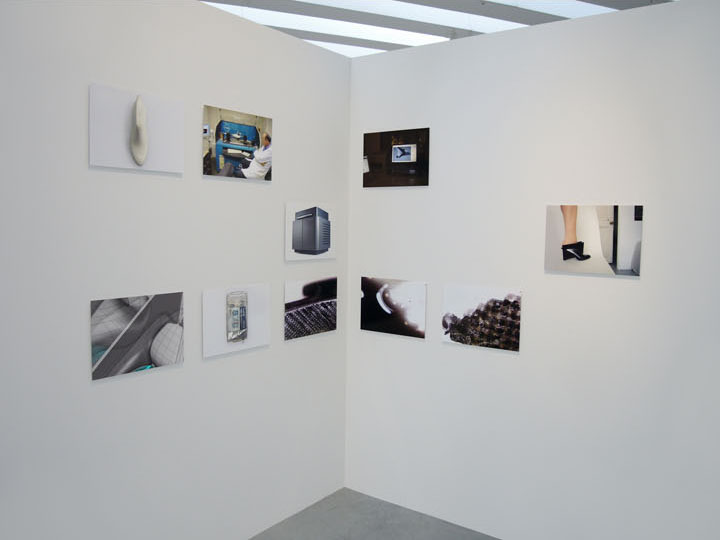
Other works on display:
After Hours / 2009
Materials: various
After Hours presents the step-by-step procedure for making Rotationalmouldedshoe, from material developments and experiments to the pouring, moulding and de-moulding process, along with a menagerie of material tests and failures, culminating in the finished pair. The stylized representation of the manufacturing process resembles a factory abandoned in the middle of production, and comments on the aesthetics, value, and economics of the machine-made.
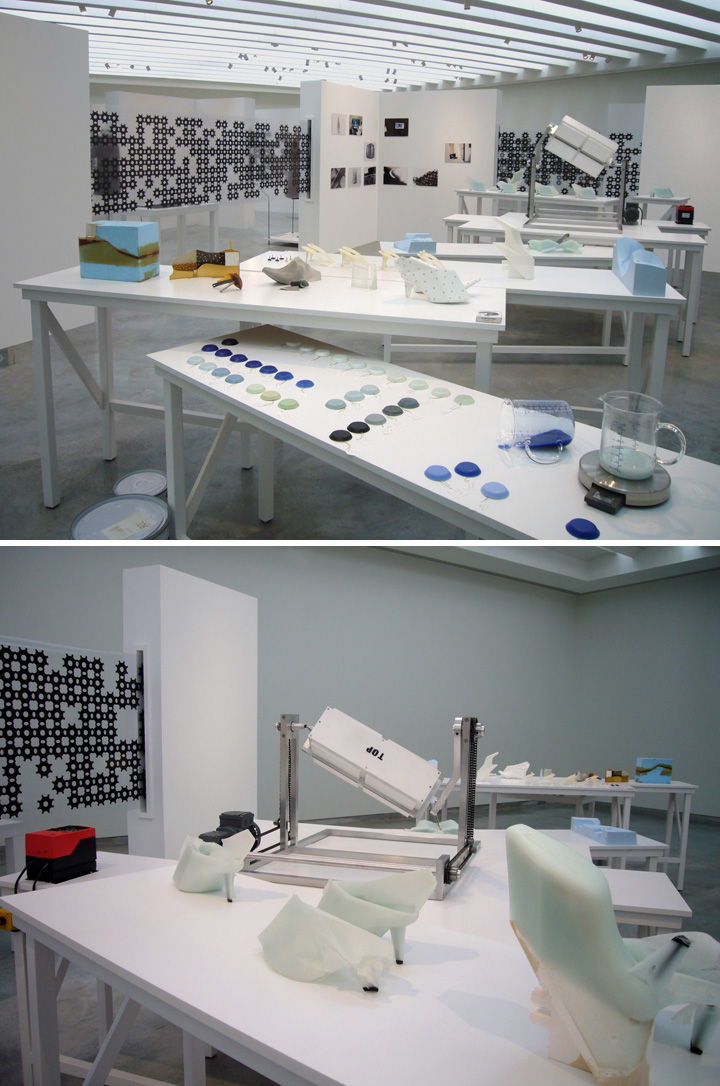 ________________________________________________________________________________________________________________________
________________________________________________________________________________________________________________________
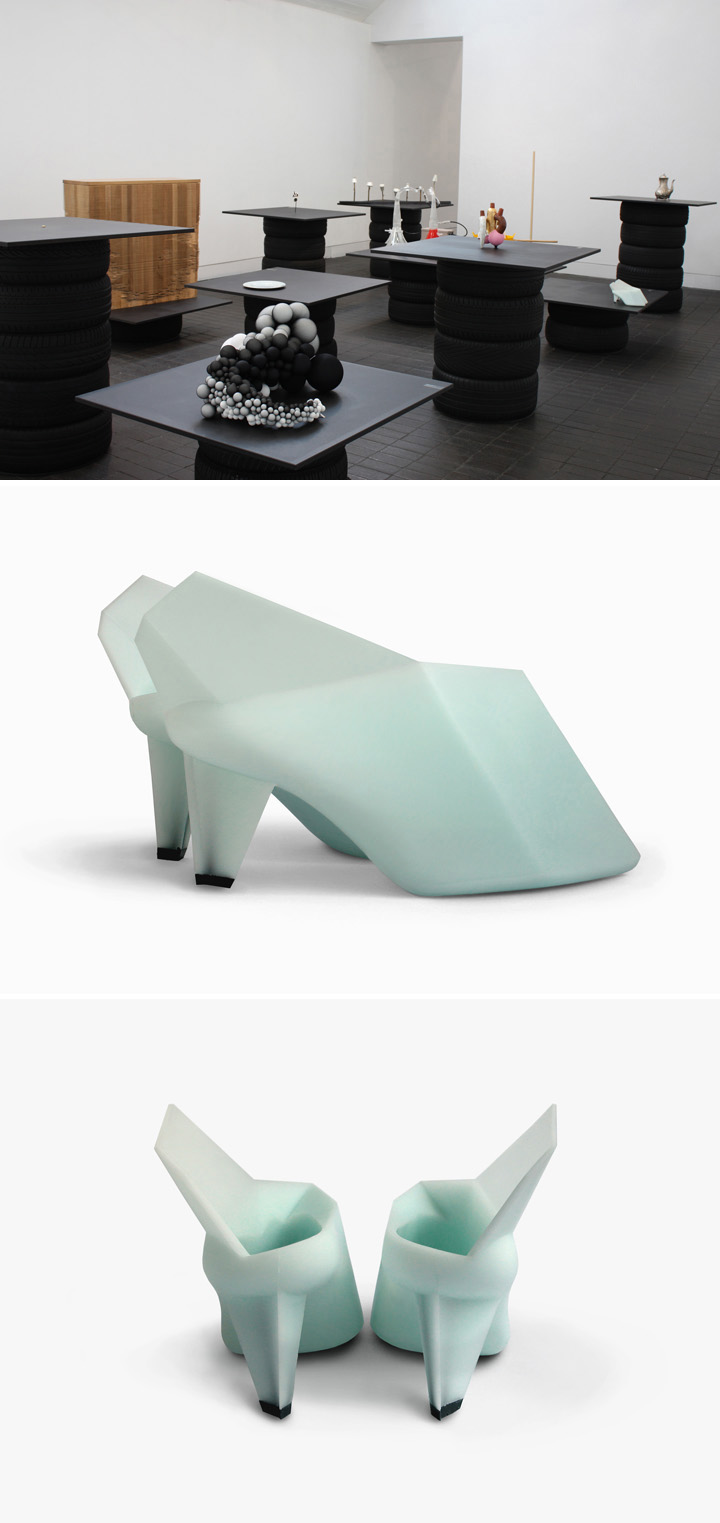 Jerwood Contemporary Makers , 17 June - 25 July 2010
Jerwood Contemporary Makers , 17 June - 25 July 2010
Jerwood Space, London
Selection panel: Hans Stofer, Richard Slee and Freddie Robins
www.jerwoodvisualarts.org
www.jerwoodspace.co.uk
Established in 2008, Jerwood Contemporary Makers is a three year initiative developed to support the applied arts and encourage new and stimulating ways of showing work across a range of disciplines. It replaces the Jerwood Applied Arts Prize, which was run in partnership with the Crafts Council for 11 years. The 2010 exhibition will be the last in the series. The 2010’s selection panel investigates the notion of making by bringing together a broad range of work from across craft and the visual arts.
Work on display:
Rotationalmouldedshoe / 2009
Materials: Polyurethane rubber and stainless steel
Rotationalmouldedshoe was specifically designed for the After Hours installation in the Krannert Art Museum in Illinois, USA.
________________________________________________________________________________________________________________________
 High, 26 April – 29 May 2010 1822-Art Forum, Frankfurt
High, 26 April – 29 May 2010 1822-Art Forum, Frankfurt
Artist, curator and exhibition designer: Zuzanna Czebatul
Photography: Jonas Leihener
Works on display:
Mouldedleathershoe / 2003
Materials: Vegetable tanned leather and carbon fibre
Sections of vegetable tanned leather, pre-formed on a variety of shoe lasts (mould that is shaped in the form of an abstracted foot), are cut and assembled to create a fractured shoe. Even though its form is distorted, one can still recover the shapes of the lasts that the parts were constructed on initially.
Bluemâchéshoe / 2003
Materials: Leather and stainless steel
The MARLOESTENBHÖMER™ leather-mâché technique is a leather laminating technique. Bluemâchéshoe traces the silhouette form of the foot on the inside, but diffuses the silhouette form of the foot on the outside.
________________________________________________________________________________________________________________________
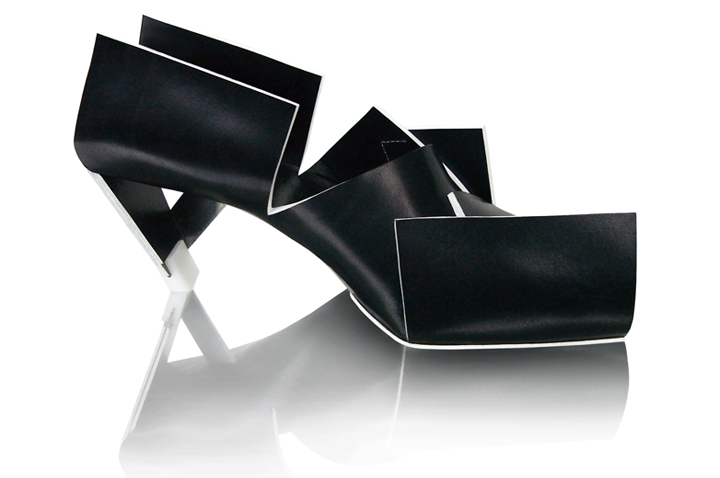 Blackfoldedshoe / 2010
Blackfoldedshoe / 2010
New colour version of -foldedshoe, is now available to order. Click here to go to the ONLINE BOUTIQUE.
________________________________________________________________________________________________________________________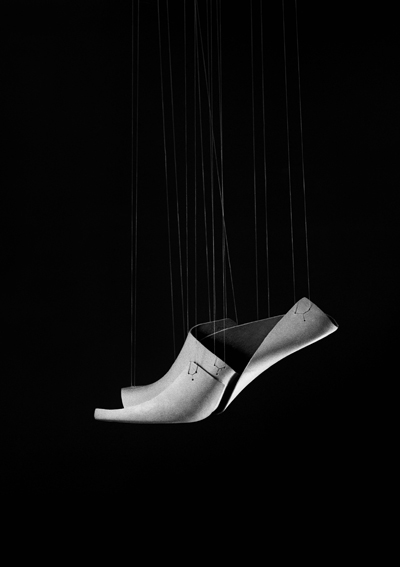
Suspendedaminationshoe / 2010
Study that explores the possible formal qualities when producing a shoe with the parameters of a foot in a high-heeled position in mind. Suspendedaminationshoe has been commissioned by Sang Blue Magazine.
www.sangbleu.com
Photographer: Adrian Wilson
________________________________________________________________________________________________________________________
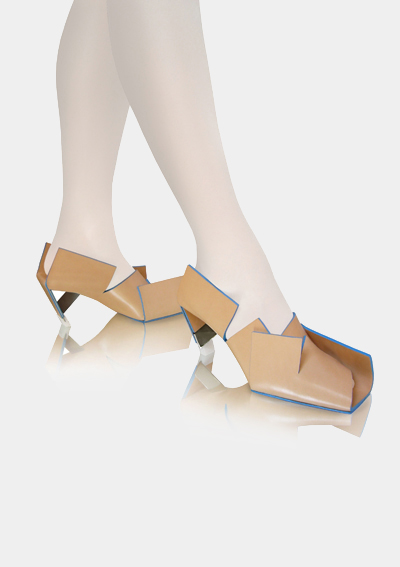
MARLOES TEN BHÖMER LAUNCHES SPECIAL EDITION SHOES AND ONLINE BOUTIQUE
The first special edition MARLOESTENBHOMER® shoes are now available to order. Click here to go to the ONLINE BOUTIQUE.
LAUNCH EVENT
Thursday July 16th 2009 at Spring Projects
Spring Projects presents an exclusive evening with critically acclaimed designer Marloes ten Bhömer launching her first commercially available shoe.
Marloes ten Bhömer launches ‘Beigefoldedshoe’, a shoe made from a single piece of folded leather and stainless steel heel construction, which stems from one of her visionary footwear concepts, transformed into a wearable shoe through two years of design and engineering development. Hand made in the UK, and incorporating technical expertise from international manufacturers.
The evening provides insight into her methods of creation, showing the end result of her fascinating use of materials and forms of construction, rarely seen in shoe design.
Spring Projects, London UK
Curator: Andree Cooke
www.springstudios.com
 ________________________________________________________________________________________________________________________
________________________________________________________________________________________________________________________
In Her Shoes, 30 May - 8 November 2009
Modemuseum Hasselt, Belgium
Curator: Kenneth Ramaekers
www.modemuseumhasselt.be
The exhibition presents the development, trends and fashion image of the woman's shoe since 1900, but also works by contemporary designers, artists and photographers who have designed or were inspired by women's shoes.
back to top
________________________________________________________________________________________________________________________
© Marloes ten Bhömer 2000-2025
